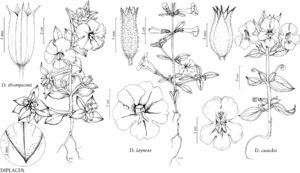Diplacus thompsonii
Phytoneuron 2013-46: 1, figs. 2, 3. 2013.
Herbs, annual, herbage usually drying dark. Stems erect, 30–150 mm, nodes 3–6, internodes 1–6 mm, glandular-puberulent. Leaves usually cauline, relatively even-sized; petiole absent, proximal base narrowed to petiole-like extension; blade lanceolate or narrowly lanceolate to elliptic-lanceolate, 7–30 × 2–7 mm, margins entire, plane, apex acute, surfaces glandular-puberulent. Pedicels 1–3 mm in fruit. Flowers 2 per node, or 1 or 2 per node on 1 plant, chasmogamous. Calyces symmetrically attached to pedicels, inflated in fruit, 7–9 mm, glandular-villous, tube strongly plicate, lobes narrowly triangular, subequal, apex acuminate to attenuate, ribs broad, darkened, blackish, thickened, strongly raised, intercostal areas whitish, membranous. Corollas dark magenta to red-purple, throat floor yellowish and red-dotted, with a red-purple midvein radiating onto base of each lobe of proximal lip, palate ridges yellow, tube-throat 10–14 mm, limb 6–10 mm diam., not bilabiate. Anthers included, ciliate. Styles puberulent. Stigmas included, lobes subequal. Capsules 7–9 mm. 2n = 16.
Phenology: Flowering May–Jul.
Habitat: Granitic soils and sands, sandy loam, outwash slopes, dry sagebrush flats, pinyon and Jeffrey pine woodlands.
Elevation: 1800–2600(–3000) m.
Distribution
Calif.
Discussion
Diplacus thompsonii is abundant along the eastern side of the Sierra Nevada in Inyo and southern Mono counties. D. M. Thompson (2005) identified these populations as intermediate between Mimulus nanus var. mephiticus and M. bigelovii; diagnostic features are more similar to those of the latter, especially the inflated and strongly wing-angled calyx and the non-bilabiate corollas. The range of D. thompsonii is within the northern limit of D. bigelovii var. cuspidatus, which is different in leaf morphology.
Selected References
None.
